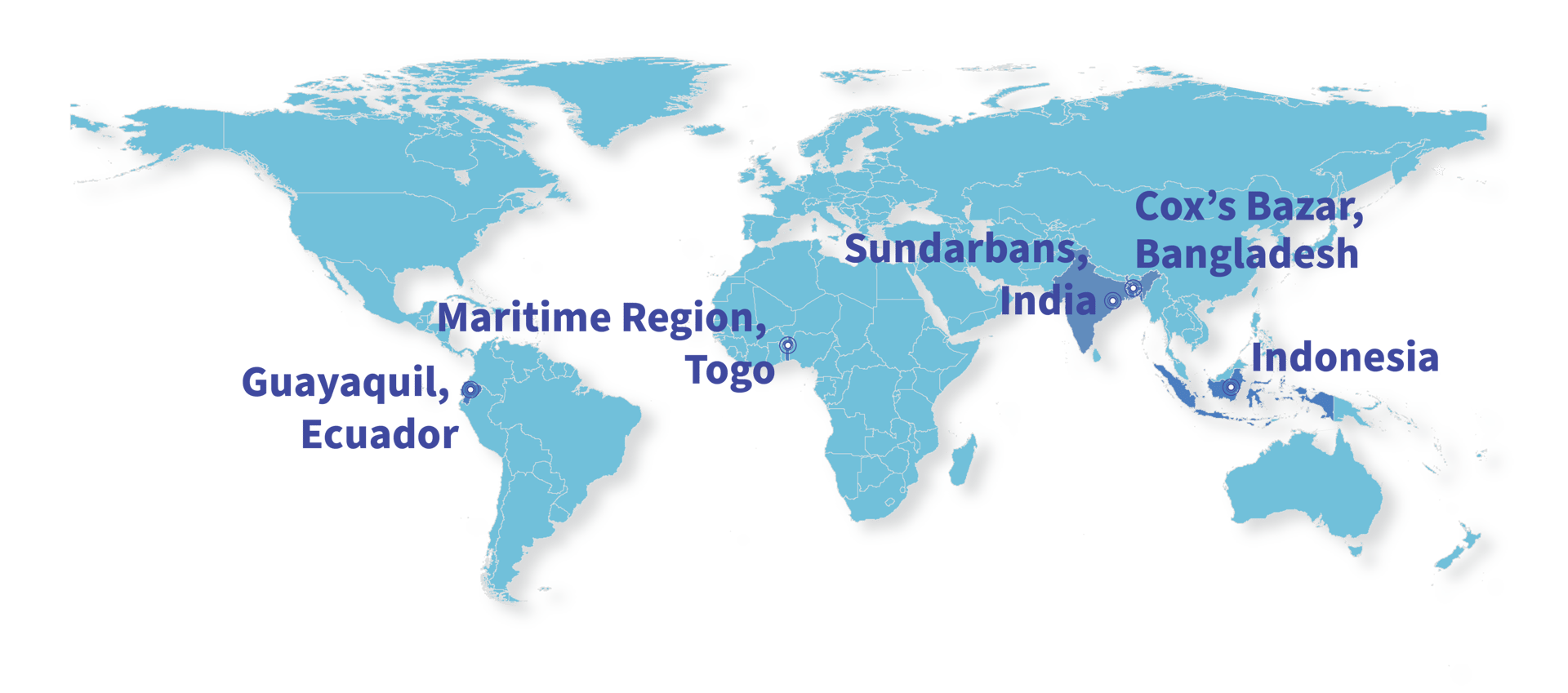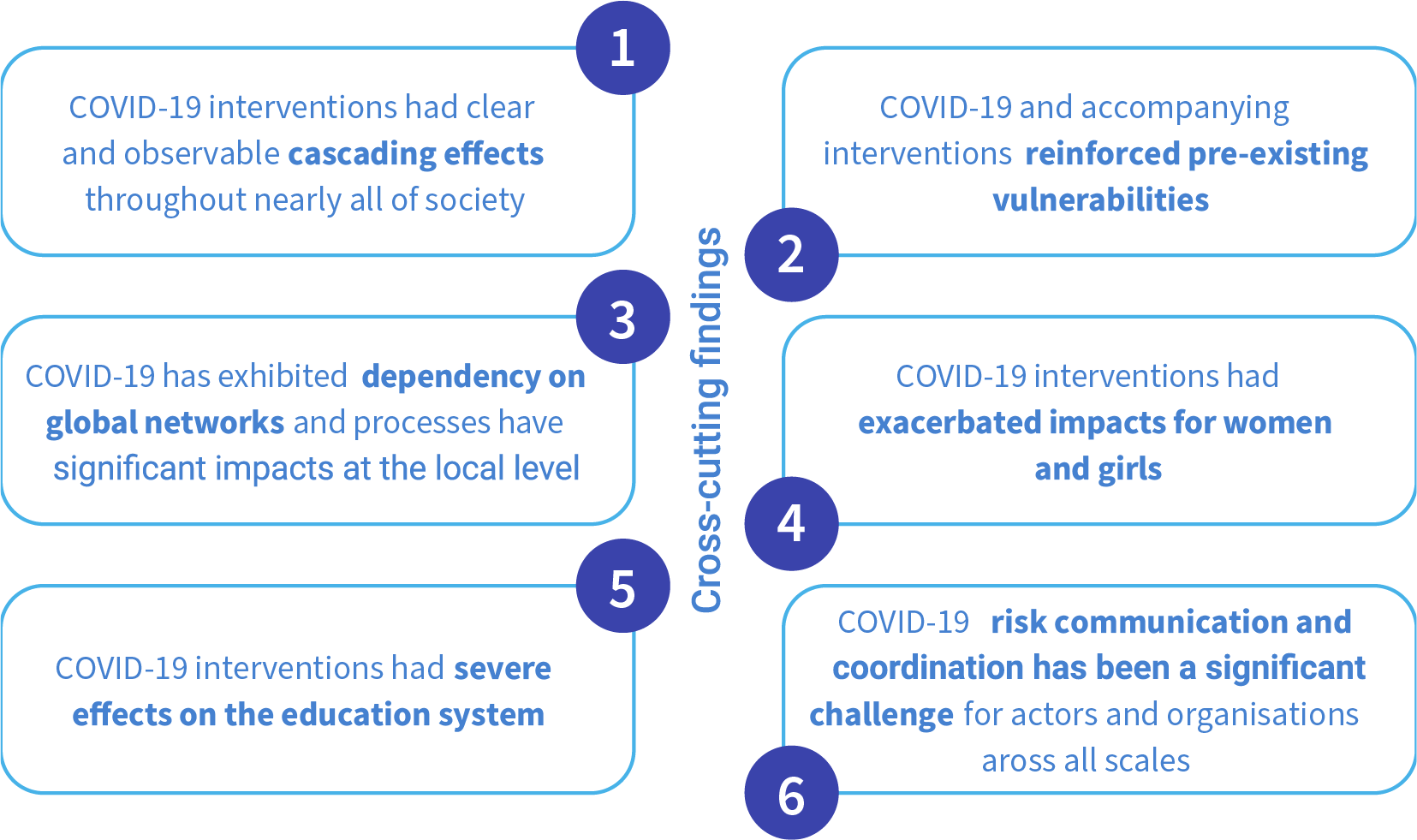Executive Summary
The COVID-19 pandemic has been tremendously difficult for many people across the globe. What was initially viewed as a health crisis affected societies to their core, many of which were already grappling with the devastating effects of climate change, as well as other challenges such as political instability and conflict.
While each of these crises has its own identifiable causes, the increasingly interconnected nature of our world means that these shocks or hazards — and the knock-on effects from them — cannot be viewed in isolation.
Indeed, the number of record-breaking disasters witnessed over the past years and their cascading effects across sectors and borders have illuminated those interconnections as never before. Similarly, interconnections became very visible when COVID-19 started to spread around the globe. The unfolding pandemic prompted a range of policy measures to limit the spread of the virus and avoid health systems becoming overwhelmed. Yet the effects of these measures, including stay-at-home orders and shutdown of public life, while highly important to prevent health system collapse and reduce COVID-19 fatalities, hit the most vulnerable the hardest. Underlying vulnerabilities such as poverty, precarious jobs in the informal economy, lack of access to education and, structural gender biases were exacerbated by the pandemic.
This report sheds light on the complexity of risks in a highly interconnected world, and presents lessons for risk management. Focusing on COVID-19, it shows how, through the interconnectedness of societies and the underlying vulnerabilities within them, the direct and indirect impacts of the pandemic have revealed the systemic nature of risk. Through a case study approach, it demonstrates how the pandemic triggered a multitude of impacts far beyond the direct health crisis, including joblessness, debt, civil and domestic violence and the derailment of their children’s education, among many others. In many locations, women suffered disproportionately, whether as a result of bias in employment patterns or other pre-existing gender biases in society. Drawing on insights from different case studies across the world, this report also offers lessons from the pandemic for understanding risk more systemically, and presents recommendations for risk management moving forward.

“This report sheds light on the complexity of risks in a highly interconnected world. Providing lessons from COVID-19, it reminds us of the importance of better understanding the interconnectedness of societies and the underlying vulnerabilities within them.”
Michael Hagenlocher, Associate Academic Officer & Lead Author of the Report, UNU-EHS
Five locations, six cross-cutting lessons

Locations in Bangladesh, Ecuador, India, Indonesia and Togo were selected to learn about the many different effects of COVID-19 in different geographic and societal contexts. In all cases, the research revealed clear domino effects that cascaded through communities, sectors and systems, exacerbating pre-existing risks and creating new ones.
The research in Guayaquil, Ecuador, provides insights into how COVID-19 overwhelmed a densely populated, overcrowded urban area. It also shows how a location’s dependence on global trade creates and reinforces vulnerabilities. In the Sundarbans, India, the concurrence of COVID-19 and a tropical cyclone created cascading risks that lead up to worrying long-term effects. In Cox’s Bazar, in neighbouring Bangladesh, pre-existing social inequity in a highly fragile setting is the backdrop to understanding the pandemic’s effects in the world’s largest refugee camp. The research in the Maritime region of Togo highlights the rural-urban and national-international interlinkages of COVID-19 in a regional Sub-Saharan context with high levels of poverty. And in Indonesia, COVID-19 led to interconnected challenges on multiple fronts: collapsing health systems, grave impacts on the economy and associated ripple effects on debt, poverty and inequalities, as well as on emergency response to other hazards that occurred amidst the pandemic.
The research in these locations allowed for the identification of a number of cross-cutting lessons:
As societies were faced with a highly dynamic and unprecedented situation, decision makers across the spectrum at times struggled with communicating the risks, as well as with coordinating the response to the pandemic.

New ways to approach risk
Many parts of the world are still grappling with COVID-19 and the human tragedy of its effects is still, unfortunately, playing out. Yet, lessons from the pandemic can already be taken away to strengthen risk management in the future.
COVID-19, and the systemic nature of risks revealed throughout the pandemic, have expanded our understanding of risk by drawing attention to the reality that hazards can emerge from outside as well as within the system. In addition, exposure can be indirect, meaning that effects can be felt in places that are not directly affected by the hazard, but could end up being impacted as a result of interdependency and interconnectedness. Finally, the vulnerability of one system can also turn into a hazard or shock for other systems.
Some key lessons stand out for developing a new approach to risk management, taking into account a “whole of society” view of systemic risk.
Today’s interconnected world is an evolving system, and disastrous events are often the results of systemic failures. The findings presented in this report point towards a deeper understanding of systemic risks, how they trigger other hazards and shocks, often in unpredictable ways. Managing these risks needs to be properly embedded in how policymakers, planners and other stakeholders approach risk management. This will create more resilient, equitable and prosperous communities and societies globally.
Get more into detail:
CONTACT
UN Campus
Platz der Vereinten Nationen 1
D–53113 Bonn
+ 49-288-815-0200
+ 49-288-815-0299
2022 © copyrights UNU-EHS



